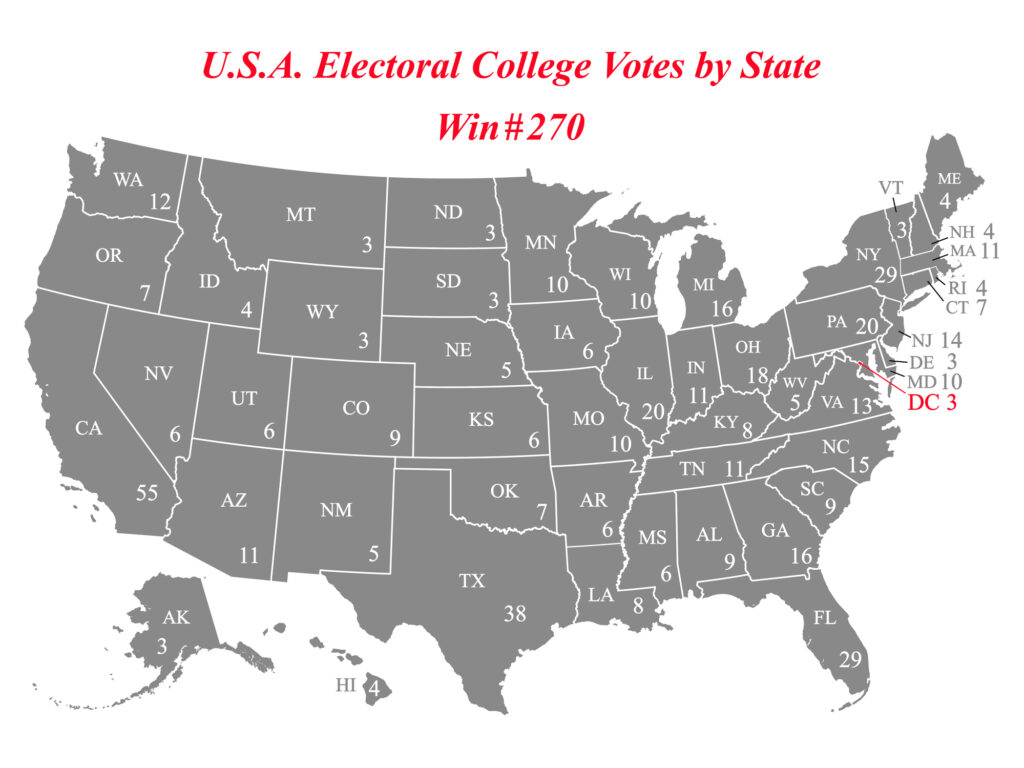Every presidential election cycle, Americans — whether voting Democrat, Republican or third-party — vote for the candidate who best aligns with the issues they care about most. Ultimately, however, the 237-year-old Electoral College determines who wins the White House. This controversial system has led many to question whether voters’ voices truly matter at the ballot box.
A candidate needs 270 electoral votes to win the presidency. In U.S. history, only five presidents have lost the popular vote but still won the election, with the most recent being Donald Trump in 2016. His opponent, Hillary Clinton, received over 2.8 million more votes than he did nationwide, according to CBS News.
Here is an overview of the Electoral College and why some believe it’s time to adopt a different Democratic model.

How does the Electoral College work?
According to the U.S. Election Assistance Commission, the Founding Fathers initiated the Electoral College and incorporated it into the Constitution in 1787. Since then, this system has been used to determine the next president and vice president of the United States. Although Americans do not directly vote for these candidates, their votes are counted based on the electors in each 50 states.
Each state and Washington, D.C., has one member of the Electoral College for every U.S. representative and U.S. senator, totaling 538 electoral votes. This total consists of 435 U.S. representatives from the 50 states, 100 U.S. senators, and three members allocated to the District of Columbia under the 23rd Amendment, ratified in 1961, according to the National Popular Vote.
Most states elect their presidential electors based on the “winner-take-all” method, but Maine and Nebraska are the only states with a different system. In these entities, one presidential elector is chosen from each congressional district in a state, with two additional electors selected based on the statewide vote. California and Texas have the largest amount of presidential electors, with 54 and 40, respectively.
According to CBS News, the electors meet in their respective states to vote for president and vice president on the first Tuesday after the second Wednesday in December following the presidential election, which falls on Dec. 17 this year.
Which states have the most electoral votes?
- Alabama: 9 votes
- Alaska: 3 votes
- Arizona: 11 votes
- Arkansas: 6 votes
- California: 54 votes
- Colorado: 10 votes
- Connecticut: 7 votes
- Delaware: 3 votes
- District of Columbia: 3 votes
- Florida: 30 votes
- Georgia: 16 votes
- Hawaii: 4 votes
- Idaho: 4 votes
- Illinois: 19 votes
- Indiana: 11 votes
- Iowa: 6 votes
- Kansas: 6 votes
- Kentucky: 8 votes
- Louisiana: 8 votes
- Maine: 4 votes
- Maryland: 10 votes
- Massachusetts: 11 votes
- Michigan: 15 votes
- Minnesota: 10 votes
- Mississippi: 6 votes
- Missouri: 10 votes
- Montana: 4 votes
- Nebraska: 5 votes
- Nevada: 6 votes
- New Hampshire: 4 votes
- New Jersey: 14 votes
- New Mexico: 5 votes
- New York: 28
- North Carolina: 16
- North Dakota: 3 votes
- Ohio: 17 votes
- Oklahoma: 7 votes
- Oregon: 8 votes
- Pennsylvania: 19 votes
- Rhode Island: 4 votes
- South Carolina: 9 votes
- South Dakota: 3 votes
- Tennessee: 11 votes
- Texas: 40 votes
- Utah: 6 votes
- Vermont: 3 votes
- Virginia: 13 votes
- Washington: 12 votes
- West Virginia: 4 votes
- Wisconsin: 10 votes
- Wyoming: 3 votes
Why is the Electoral College still in use?
The Electoral College is ultimately used to balance power at the state level in U.S. presidential elections. According to NPR, critics have called the Electoral College an undemocratic and racist system that needs revision.
“From the perspective of 2024, you know, it doesn’t seem ‘small-d’ democratic to have this sort of intermediate body between the people voting and the ultimate decision,” constitutional law expert Alison LaCroix said, NPR reported.
The framers of the Electoral College did not favor the popular vote because they feared that if Americans directly voted for president, multiple candidates would receive votes. “This concern stems from the idea that citizens of one State would not know much about the candidates from other States and that the public would naturally vote for the ‘favorite sons’ of their home States,” the U.S. Election Assistance Commission stated. “The president would likely be chosen with a very small plurality of votes from a State with a large population.”
The constitution’s architects wanted to avoid allowing Congress to decide the next president. “And then they say, well, what about an intermediate body, which becomes the Electoral College,” LaCroix said. “[It] solves the problem of the president being too beholden to Congress. It’s a temporary body. It’s not some entity that has ongoing power.”
What are Americans’ views on the Electoral College?
According to a September report from the Pew Research Center, most more than 63% of Americans believe there should be a different system to determine the next president of the United States. In a poll on their thoughts about the Electoral College, 87% of liberal Democrats and 74% of conservative and moderate Democrats favored deciding the election through the popular vote. However, 63% of conservative Republicans support keeping the Electoral College in place.
These trends indicate a shift in public opinion, as many Americans seek a more direct method for electing their president. As calls for reform grow louder, it remains unknown whether lawmakers will acknowledge and act on the public’s desire for change.
